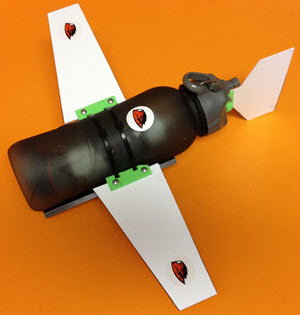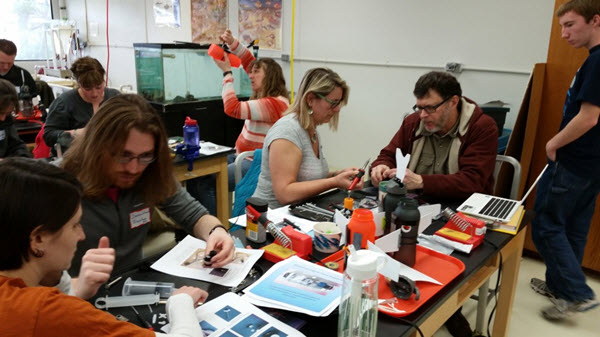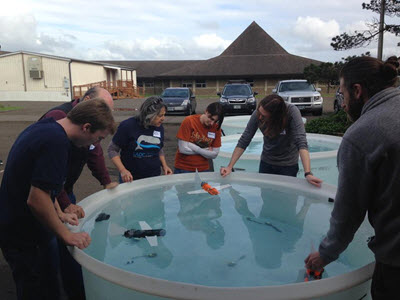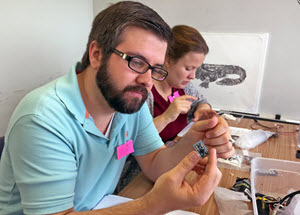
Christopher Hatten of Mildred Osborne Charter School contemplates the Arduino microcontroller board that he will later program to run his SeaGlide model. (Photo by Dinah Maygarden)
Researchers from Oregon State University, the University of New Orleans, and Proteus Technologies explained how they use ocean gliders to collect temperature, pressure, and acoustic data such as sounds made by Gulf of Mexico whales and dolphins. The Littoral Acoustic Demonstration Center – Gulf Ecological Monitoring and Modeling (LADC-GEMM) team guided the participants in constructing their own SeaGlide models assisted by eight Warren Easton Charter High School students with experience building the model gliders.
SeaGlide models are fully functioning miniature gliders that, like “real” gliders, collect data and take in and expel water to change their buoyancy and propel themselves forward. The kits are designed to guide users through the building process while teaching them the foundations behind the technology. The participants learned about basic electronics so they could solder and program the gliders’ circuit boards and built servo-driven engines that manage the gliders’ buoyancy and pitch.
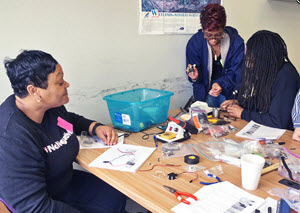
Julian DeRouen (far right), an advanced physics student from Warren Easton Charter High School, shows Fifth Ward Elementary’s Rhodie Simms and West St. John Elementary’s Angela Farnell how to assemble the electronics for their glider models. (Photo by Sara Heimlich)
Workshop participants consisted of 5th – 12th grade educators working in local schools and after-school programs. Most participants said that they thought the hands-on building experience was the most valuable part of the workshop and expressed an intention to incorporate what they learned into their school-year, after-school, or summer curriculums. Some expressed an interest in teaching the material for as long as three or four weeks, while others considered incorporating the gliders as a weekly activity throughout the entire school year. The majority of participants reported that the workshop made them feel more confident in their ability to teach overall science, technology, engineering, and math (STEM) principles.
***********
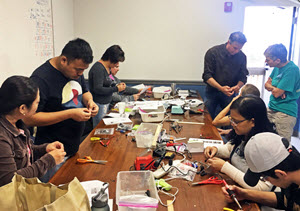
Proteus Technologies’ Sean Griffin guides participants through the delicate process of soldering electronic parts onto the programmable computer chips that control the model gliders’ movements. (Photo by Kendal Leftwich)
This research was made possible in part by a grant from the Gulf of Mexico Research Initiative (GoMRI) to the Littoral Acoustic Demonstration Center – Gulf Ecological Monitoring and Modeling (LADC-GEMM) consortium.
The Gulf of Mexico Research Initiative (GoMRI) is a 10-year independent research program established to study the effect, and the potential associated impact, of hydrocarbon releases on the environment and public health, as well as to develop improved spill mitigation, oil detection, characterization and remediation technologies. An independent and academic 20-member Research Board makes the funding and research direction decisions to ensure the intellectual quality, effectiveness and academic independence of the GoMRI research. All research data, findings and publications will be made publicly available. The program was established through a $500 million financial commitment from BP. For more information, visit http://gulfresearchinitiative.org/.
© Copyright 2010- 2017 Gulf of Mexico Research Initiative (GoMRI) – All Rights Reserved. Redistribution is encouraged with acknowledgement to the Gulf of Mexico Research Initiative (GoMRI). Please credit images and/or videos as done in each article. Questions? Contact web-content editor Nilde “Maggie” Dannreuther, Northern Gulf Institute, Mississippi State University (maggied@ngi.msstate.edu).
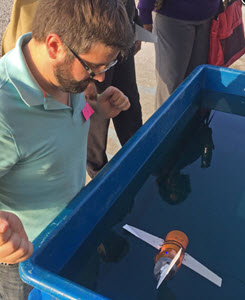
Hatten tests his finished model in a water tank. (Photo by Dinah Maygarden)
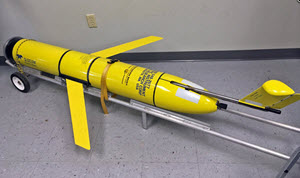
The workshop used this glider, provided by Stephan Howden of the University of Southern Mississippi, to demonstrate the type of gliders used in LADC-GEMM research. (Photo by Sara Heimlich)

